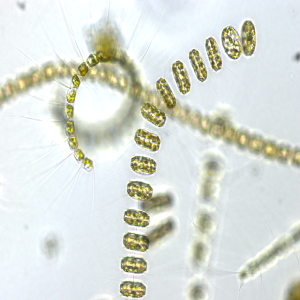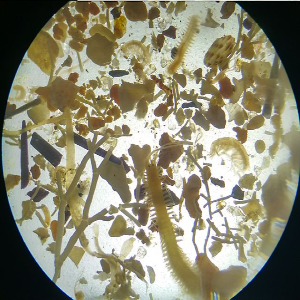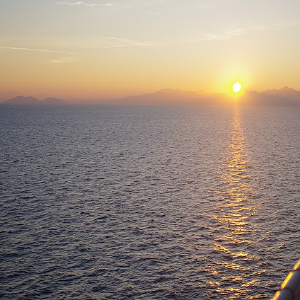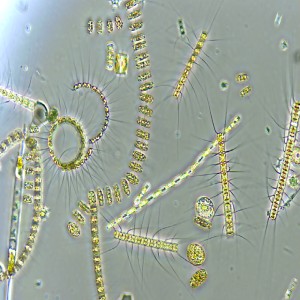An autumn biodiversity survey on heterotrophic and mixotrophic protists along a coast-to-offshore transect in the Gulf of Naples (Italy)
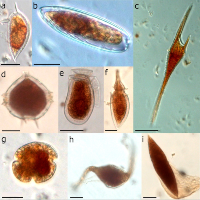
Accepted: 22 November 2021
HTML: 106
Supplementary Materials: 0
Supplementary Materials: 0
All claims expressed in this article are solely those of the authors and do not necessarily represent those of their affiliated organizations, or those of the publisher, the editors and the reviewers. Any product that may be evaluated in this article or claim that may be made by its manufacturer is not guaranteed or endorsed by the publisher.
Plankton communities include both unicellular and multicellular organisms. An important unicellular component is represented by those protists (i.e., unicellular eukaryotes) that consume bacteria, other protists, and even small animals. These organisms are an important link between primary producers and metazoans, and they can also be ‘mixotrophic’, coupling phagotrophic and photoautotrophic behaviours. In this note, we report on the diversity of heterotrophic protists, or protozoo-plankton (from ‘protozoan plankton’), and mixotrophic protists, or mixo-plankton , which were sampled at two sites (coastal and offshore stations), at two depths (0 and 10 m), in the Gulf of Naples during the early autumn of 2020. Our survey identified dinoflagellates and oligotrich ciliates as the most abundant groups, while tintinnids (choreotrich ciliates) were less quantitatively relevant. The taxonomic composition in samples investigated herein remarked that reported by previous studies, except for the tintinnid Ascampbeliella armilla. A coast-to-offshore differentiation in the taxonomical composition of heterotrophic and mixotrophic protists was also observed, with some species more abundant within coastal waters and other better thriving in offshore ones. These differences were associated with distinct environmental and trophic conditions.
Caroppo C, 2001. Autoecology and morphological variability of Dinophysis sacculus (Dinophyceae: Dinophysiaceae) in a mediterranean lagoon. Journal of the Marine Biological Association of the United Kingdom 81:11–21.
D'Alelio D, Mazzocchi MG, Montresor M, Sarno D, Zingone A, Di Capua I, et al., 2015. The green-blue swing: plasticity of plankton food-webs inresponse to coastal oceanographic dynamics. Marine Ecology 36.4: 1155-1170.
D’Alelio D, Libralato S, Wyatt T, Ribera d’Alcalà M, 2016a. Ecological-network models link diversity, structure and function in the plankton food-web. Scientific Reports 6:1–13.
D’Alelio D, Montresor M, Mazzocchi MG, Margiotta F, Sarno D, Ribera d’Alcalà M, 2016b. Plankton food-webs: to what extent can they be simplified? Advances in Oceanography and Limnology 7:67–92.
Dolan JR, 2010. Morphology and ecology in tintinnid ciliates of the marine plankton: correlates of lorica dimensions. Acta Protozoologica 49:235–244.
Dolan JR, 2017. Historical trends in the species inventory of tintinnids (ciliates of the microzooplankton) in the Bay of Villefranche (NW Mediterranean Sea): shifting baselines. European journal of protistology 57:16-25.
Dolan JR, Ciobanu M, Marro S, Coppola L, Ji R, 2019. An exploratory study of heterotrophic protists of the mesopelagic Mediterranean Sea. ICES Journal of Marine Science 76:616–625.
Dolan JR, Pérez MT, 2000. Costs, benefits and characteristics of mixotrophy in marine oligotrichs. Freshwater Biology 45:227–238.
Durán M, 1951. [Contribución al estudio de los tintínidos del plancton de las costas de Castellón (Mediterráneo occidental)].[Article in Spanish].
Esteban GF, Fenchel T, Finlay BJ, 2010. Mixotrophy in ciliates. Protist 161:621–641.
Flynn KJ, Mitra A, Anestis K, Anschütz AA, Calbet A, Ferreira GD, et al., 2019. Mixotrophic protists and a new paradigm for marine ecology: where does plankton research go now? Journal of Plankton Research 41:375–391.
Flynn KJ, Stoecker DK, Mitra A, Raven JA, Glibert PM, Hansen PJ, et al., 2013. Misuse of the phytoplankton-zooplankton dichotomy: the need to assign organisms as mixotrophs within plankton functional types. Journal of Plankton Research 35:3–11.
Gomez F, 2018. Redefinition of Ceratoperidinium and Pseliodinium (Ceratoperidiniaceae, dinophyceae) including reassignment of Gymnodinium fusus, Cochlodinium helix and C. pirum to Pseliodinium. CICIMAR Oceánides 33:1–11.
Gómez F, Takayama H, Moreira D, López-García P, 2016. Unarmoured dinoflagellates with a small hyposome: Torodinium and Lebouridinium gen. nov. for Katodinium glaucum (Gymnodiniales, Dinophyceae). European Journal of Phycology 51:226–241.
Gutiérrez-Rodríguez A, Décima M, Popp BN, Landry MR, 2014. Isotopic invisibility of protozoan trophic steps in marine food webs. Limnology and Oceanography 59:1590–1598.
Hansen HP, 1983. Automated chemical analysis, p.347-395. In: Grasshoff K, Kremling K, Ehrhardt M (eds.), Methods of seawater analysis.
Hansen PJ, 2011. The role of photosynthesis and food uptake for the growth of marine mixotrophic dinoflagellates. Journal of Eukaryotic Microbiology 58:203–214.
Haraguchi L, Jakobsen HH, Lundholm N, Carstensen J, 2018. Phytoplankton community dynamic: a driver for ciliate trophic strategies. Frontiers in Marine Science 5:1–16.
Hedges JI, Stern JH, 1984. Carbon and nitrogen determinations of carbonate‐containing solids. Limnology and oceanography 29:657-663.
Hughes EA, Maselli M, Sørensen H, Hansen PJ, 2021. Metabolic reliance on photosynthesis depends on both irradiance and prey availability in the mixotrophic ciliate, Strombidium cf. basimorphum. Frontiers in Microbiology 12:1577.
Jeong HJ, Du Yoo Y, Kim JS, Seong KA, Kang NS, Kim TH, 2010. Growth, feeding and ecological roles of the mixotrophic and heterotrophic dinoflagellates in marine planktonic food webs. Ocean Science Journal 45:65–91.
Jeong HJ, Yeong DY, Jae YP, Jae YS, Seong TK, Seung HL, et al., 2005. Feeding by phototrophic red-tide dinoflagellates: five species newly revealed and six species previously known to be mixotrophic. Aquatic Microbial Ecology 40:133–150.
Johnson MD, 2011. Acquired phototrophy in ciliates: a review of cellular interactions and structural adaptations. Journal of Eukaryotic Microbiology 58:185-195.
Johnson MD, Oldach D, Delwiche CF, Stoecker DK, 2007. Retention of transcriptionally active cryptophyte nuclei by the ciliate Myrionecta rubra. Nature 445:426–428.
Johnson MD, Stoecker DK, Marshall HG, 2013. Seasonal dynamics of Mesodinium rubrum in Chesapeake Bay. Journal of Plankton Research 35:877–893.
Kokoszka F, Iudicone D, Zingone A, Saggiomo V, Ribera d’Alcalà M, Conversano F, 2021. Advances in Oceanography and Limnology (AIOL Journal) (in press).
Leles SG, Bruggeman J, Polimene L, Blackford J, Flynn KJ, Mitra A, 2021. Differences in physiology explain succession of mixoplankton functional types and affect carbon fluxes in temperate seas. Progress in Oceanography 190:102481.
Margiotta F, Mangoni O, Santarpia I, Saggiomo M, Saggiomo V, Casotti R, 2013. Biologia Marina Mediterranea 20:214.
Maselli M, Altenburger A, Stoecker DK, Hansen PJ, 2020. Ecophysiological traits of mixotrophic Strombidium spp. Journal of Plankton Research 42:485–496.
Metsalu T, Vilo J, 2015. ClustVis: a web tool for visualizing clustering of multivariate data using principal component analysis and heatmap. Nucleic Acids Research 43:566–570.
Mitra A, Castellani C, Gentleman WC, Jónasdóttir SH, Flynn KJ, Bode A, et al., 2014. Bridging the gap between marine biogeochemical and fisheries sciences; configuring the zooplankton link. Progress in Oceanography 129:176–199.
Mitra A, Flynn KJ, Tillmann U, Raven JA, Caron D, Stoecker DK, et al., 2016. Defining planktonic protist functional groups on mechanisms for energy and nutrient acquisition: incorporation of diverse mixotrophic strategies. Protist 167:106–120.
Modigh M, 2001. Seasonal variations of photosynthetic ciliates at a Mediterranean coastal site. Aquatic Microbial Ecology 23:163–175.
Modigh M, Castaldo S, 2002. Variability and persistence in tintinnid assemblages at a Mediterranean coastal site. Aquatic Microbial Ecology 28:299–311.
Park MG, Lee H, Kim KY, Kim S, 2011. Feeding behavior, spatial distribution and phylogenetic affinities of the heterotrophic dinoflagellate Oxyphysis oxytoxoides. Aquatic Microbial Ecology 62:279–287.
Piredda R, Tomasino MP, D’Erchia AM, Manzari C, Pesole G, Montresor M, et al., 2017. Diversity and temporal patterns of planktonic protist assemblages at a Mediterranean long-term ecological research site. FEMS Microbiology Ecology 93:fiw200.
Polat S, Kurt TT, Tuğrul S, 2019. Spatial and temporal variations of tintinnids (Ciliata: Protozoa) in the Bay of Mersin, Northeastern Mediterranean Sea. Mediterranean Marine Science 20:342-356.
Ribera d’Alcalà M, Conversano F, Corato F, Licandro P, Mangoni O, Marino D, et al., 2004. Seasonal patterns in plankton communities in pluriannual time series at a coastal Mediterranean site (Gulf of Naples): an attempt to discern recurrences and trends. Scientia Marina 68:65–83.
Schneider L, Anestis K, Mansour J, Anschütz A, Gypens N, Hansen P, et al., 2020. A dataset on trophic modes of aquatic protists. Biodiversity Data Journal 8:e56648.
Smalley GW, Coats DW, Stoecker DK, 2003. Feeding in the mixotrophic dinoflagellate Ceratium furca is influenced by intracellular nutrient concentrations. Marine Ecology Progress Series 262:137–151.
Smith M, Hansen PJ, 2007. Interaction between Mesodinium rubrum and its prey: importance of prey concentration, irradiance and pH. Marine Ecology Progress Series 338:61–70.
Stoecker DK, Hansen PJ, Caron DA, Mitra A, 2017. Mixotrophy in the marine plankton. Annual Review of Marine Science 9:311-335.
Stoecker DK, Johnson MD, De Vargas C, Not F, 2009. Acquired phototrophy in aquatic protists. Aquatic Microbial Ecology 57:279–310.
Utermöhl H, 1958. Toward the improvement of the quantitative phytoplankton method. Mitteilungen-Internationale Vereiningung fur Limnologie 9:1–38.
Vidussi F, Claustre H, Bustillos-Guzmàn J, Cailliau C, Marty JC, 1996. Determination of chlorophylls and carotenoids of marine phytoplankton: separation of chlorophyll a from divinylchlorophyll a and zeaxanthin from lutein. Journal of plankton research 18:2377-2382.
Zingone A, Casotti R, Ribera d’Alcalà M, Scardi M, Marino D, 1995. 'St Martin's Summer': the case of an autumn phytoplankton bloom in the Gulf of Naples (Mediterranean Sea). Journal of Plankton Research 17:575-593.
Zingone A, D’Alelio D, Mazzocchi MG, Sarno D, 2019. Time series and beyond: multifaceted plankton research at a marine Mediterranean LTER site. Nature Conservation 310:273–310.
PAGEPress has chosen to apply the Creative Commons Attribution NonCommercial 4.0 International License (CC BY-NC 4.0) to all manuscripts to be published.



 https://doi.org/10.4081/aiol.2021.10018
https://doi.org/10.4081/aiol.2021.10018




